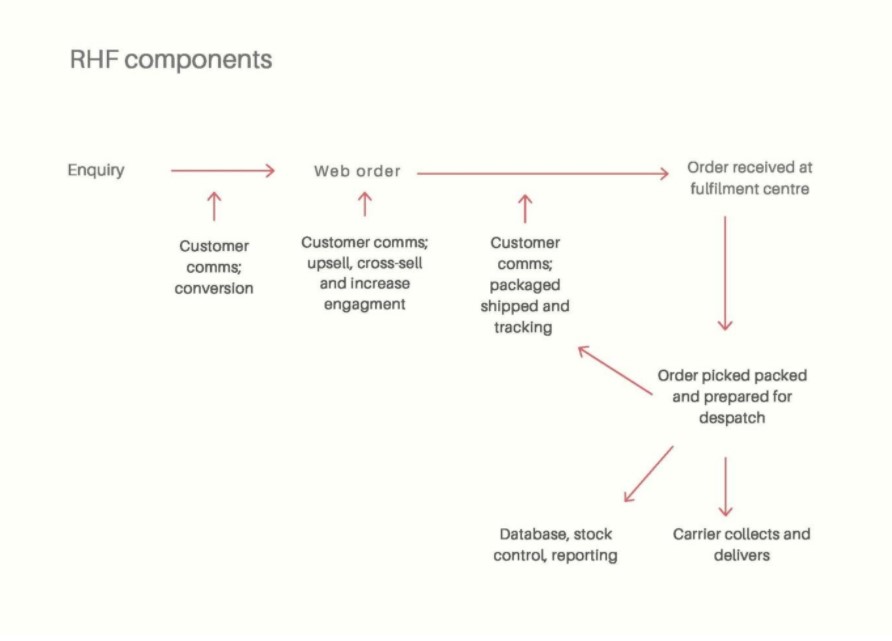Richard Price, Fruit Marketing

So, you’ve decided to grow your online business.
You’ve evaluated your market potential, assessed competitive activity, fine-tuned your proposition and pricing, established a robust supply chain and set SMART objectives for e-commerce growth.
You’ve spent time updating and optimising your website and now you need to focus on the operation of handling enquiries and fulfilling orders.
In this article, we examine the components of RHF in more detail and discuss the pros and cons of doing it in-house versus an out-sourced solution.
A clear understanding of the process will not only help you manage it better, but also give you an appreciation of the value offered by specialist RHF partners.

Let’s look at some of these elements in more detail.
Enquiry
This could be an email sign-up, a web form, a phone call, a social media message; or your website may be able to identify visitors getting quotes and/or abandoning baskets. So, consider how you’re going to capture, collate and respond to these enquiries to nudge them towards a sale.
Web order
How will you process these?
You may already have, or be considering, an e-commerce platform. Do some research on what they can do and whether they suit your kind of product.
Services offered by such platforms include web design build and hosting, inventory management, returns management, reviews, Search Engine Optimisation (SEO), and Customer Relationship Management (CRM).
Check if they include payment processing or how easily they integrate with payment processors. Do they work across different devices (phone, tablet, laptop)? What’s their level of support? How scale-able are they and how much do they charge?
Some well-known platforms to check out include Shopify, Big Cartel, GoDaddy, Big Commerce, WooCommerce, Magento, EKM, Etsy, eBay and Amazon.
Order fulfilment
Orders received should first be auto-checked against stock availability. If ok, the order is released for picking and packing. Your process should generate customer messaging to advise of order confirmation or no stock.
Order picked, packed and prepared for despatch

As discussed in the last article, be clear about your service levels and manage your customers’ expectations of these. Do you want same-day cut off – if so, when is optimal? Will you offer free standard delivery? Can customers upgrade to next-day or defined time-slots? How will you keep your customer updated on the process from receipt to despatch? In recent times, Amazon has set the bar in this regard, so you’ll need to bench-mark against this.
Picking and packaging will depend on your product. Standard small sizes may be machine-able, bulkier or varied packs may need hand enclosing.
Similarly, your packaging will reflect both your product and your brand promise. Envelopes could range from standard size, one colour overprinted to bespoke size, shape and full colour design. Small packages can similarly range from off-the-peg to tailored formats, and large packages may be led by practical logistical considerations. Think about costs – not just those of packaging materials but also the most cost-effective formats for the postal or courier service.
Carriers and deliveries

As elsewhere in the RHF process, ask yourself the following questions:
Database, reporting and stock control
When an enquiry or order is made, what data do you need to capture? What useful additional data can you ask for (with permission)? Think about address checking, deduplication, promotion or media codes and repeat customer recognition.
Once captured, how is that data used for accounts, marketing communication and the fulfilment/delivery operation? What information do you need and when do you need it? Always consider actionable data, rather than ‘nice-to-have’.
Example reports could include:
UK and international orders
With an e-commerce model, you have the potential to attract international business. Do you fulfil all these in the same way? Are costs the same? What about address checking, data protection regulations and delivery times? Will you use the same despatch companies? How does Brexit affect international deliveries?

In-house versus out-source
If you’ve got this far, you’ll know there are lots of considerations and questions to answer.
Let’s try to evaluate the pros and cons of handling Response and Order Fulfilment in-house versus out-sourcing to a specialist agency.
In-house
Small businesses starting out may opt for in-house. This can be sensible if sales volumes are low and steady, and cash-flow for paying your RHF partner in short supply. There’s useful guidance for the DIY approach on the Royal Mail’s website – whether you’re selling on marketplaces like Amazon, eBay or Etsy, or you’re operating in a niche such as fashion/beauty, pharmacy/healthcare or food/drink and more. https://www.royalmail.com/business/delivery-solutions
But with your plans for e-commerce growth, you’ll need to be asking the following questions about your RHF provision:
You may think you’re saving costs, but have you identified the actual opportunity costs of the in-house solution? What else could you be doing productively if you weren’t packing and despatching orders?
Out-source
As sales grow, you realise you need a scalable resource and therefore look for outside help. If possible, anticipate this as part of your planning rather than reacting late once you have a problem that could affect your customers’ experience.
Considering the RHF processes illustrated and discussed above, how much of it do you delegate to your RHF partner? As well as order processing, think data, customer communications, sourcing packaging and selecting carriers. Do you want them to handle complaints as well as returns?
How to choose an RHF partner
Having thought about your requirements, write up an outline brief as this will help you in finding potential partners.
Key elements of the brief should include a summary of your requirements and current business situation along with outline objectives, why you are looking for RHF help, likely scope and scale of activity, what you’d like to see in the proposal, and how it will be assessed – along with a clear timeline.
With your brief drafted, you now need to find some candidate partners. Start with desk research – you may have come across some already. Have a look at what other similar businesses may be doing, check local business networks or search online. The Data and Marketing Association (DMA) member directory could be a useful source. https://dma.org.uk/
With a long list of 8-10 candidates, you should try to whittle this down to a shortlist of 3–4. This can be done by more research, conversations with the suppliers and assessing what you find against your selection criteria.
It can be helpful to develop a scorecard for more objective candidate assessment – which could cover capabilities, experience, locations, “fit” (size, culture, other clients), scalability, service levels, data integration, accreditations, client reviews and testimonials.
With your shortlist confirmed, you can send out your brief and ask for proposals; if practical you should try to meet the key personnel and visit their operation as part of the process.
Give yourself enough time to make a sensible decision and inform the short-listed candidates as soon as possible.
If all goes well, you’ll have a partner you can trust to (literally) deliver for you. More expert help is available through E-Channel. The project aims to provide a joined-up package of support for SMEs looking to enter new markets using e-commerce – either within the UK or cross border. For more see https://www.e-channel.org